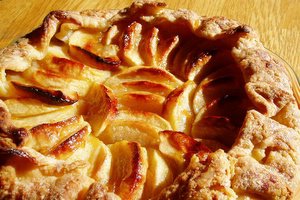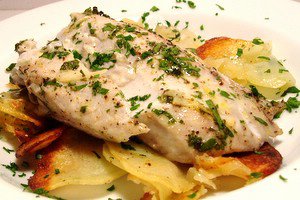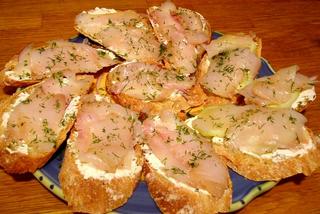
On my drive home from work, my head was swimming with pumpkin ideas for Elise's
Great Pumpkin Carve Up Cook Off food blog event. But as I got home and started reheating dinner, it suddenly occurred to me that the perfect pumpkin dish was staring me in the face. It never occurred to me to write about my homey Pumpkin Kasha. Somehow it seemed so non-gourmet, so simple.
You are probably thinking of buckwheat with pumpkin -- an odd combination indeed. Let me explain the name. In Russia, Kasha refers to a dish cooked out of any grain (buckwheat, oats, wheat, millet, barley, rice, etc). Just like not all pasta is spaghetti, not all kasha is buckwheat. This particular kasha is made with rice. It is somewhere between risotto and rice pudding -- with puffed up rice grains wrapped in pumpkin creaminess. No cinnamon, no nutmeg, nothing to distract form the flavor of pumpkin. The only thing I sometimes add are raisins. Not to say that spices wouldn't be good in this dish, but they are not traditional, and it's never a good idea to mess with your childhood memories.
I didn't carve a pumpkin for this dish, but since this was yesterday's dinner leftovers, I figured it was in the right spirit of not wasting pumpkin.
I did play around with it a little and made pumpkin rice cakes and pumpkin kasha brulee just for fun. The rice cakes were particularly good drizzled with maple syrup.
Serves 61 sugar pumpkin or butternut squash
1 1/2 cups risotto rice (Arborio, Carnaroli, etc)
3 cups water
1 Tbsp kosher salt
2 cups milk
2/3 cups raisins (optional)
2 Tbsp butter
- Preheat the oven to 375F.
- Cut the pumpkin in half, scoop out the seeds, place cut side down on an oiled baking sheet and bake for 1 hour or until tender. Scoop out pumpkin flesh and mash.
- In a large heavy pot, combine rice, water and half Tbsp salt. Bring to a boil, reduce heat to low, cover, and cook until rice is almost tender, 15-20 minutes.
- Add the milk and another half Tbsp salt, bring to a simmer, cover and cook on very low stirring occasionally until rice is tender and most of the milk is absorbed, 20-30 minutes. Taste and correct seasoning.
- Add the pumpkin and raisins, and cook another 5-10 minutes.
- Stir in the butter and serve.
To make pumpkin rice cakes, chill pumpkin kasha overnight. Shape into patties, dredge in bread crumbs (panko works best), and fry on both sides in 1 Tbsp butter.
To make pumpkin kasha brulee, scoop into ramekins, smooth the top, sprinkle with sugar and put under the broiler until browned, 4-5 minutes (check every minute since broilers differ). But I must say that it tastes better just sprinkled with a little sugar.
 Hands-on salad
Hands-on salad How to make fish stock
How to make fish stock On board -- a closer look at knife's best friend
On board -- a closer look at knife's best friend A juicy guide to citrus fruit
A juicy guide to citrus fruit Playing with fire -- how to broil
Playing with fire -- how to broil The cutting edge -- how to choose and sharpen knives
The cutting edge -- how to choose and sharpen knives How to make pasta dough
How to make pasta dough How to Work with Leeks
How to Work with Leeks How to Cook Swiss Chard
How to Cook Swiss Chard How to season (and all about salt)
How to season (and all about salt) How to grill fish
How to grill fish How to cook a whole fish
How to cook a whole fish FAQ about Herbs
FAQ about Herbs How to cook asparagus
How to cook asparagus Making Pie and Tart Dough (pâte brisée)
Making Pie and Tart Dough (pâte brisée) Rolling out and baking tart dough
Rolling out and baking tart dough Making sushi rice
Making sushi rice Sectioning an orange
Sectioning an orange

 This is a good post to end the grilling season since this mahi was one of the juiciest, most flavorful pieces of fish that ever came off my grill. Since we just got our first snow in Boston (end of October -- can you believe it?!), I probably won't get to grill much longer.
This is a good post to end the grilling season since this mahi was one of the juiciest, most flavorful pieces of fish that ever came off my grill. Since we just got our first snow in Boston (end of October -- can you believe it?!), I probably won't get to grill much longer. Lots of non-fish entries lately. Sorry, I can't help it. Now that I keep my digital camera in the kitchen, it's hard not to take pictures. And once you start taking pictures of food, it's hard not to post them.
Lots of non-fish entries lately. Sorry, I can't help it. Now that I keep my digital camera in the kitchen, it's hard not to take pictures. And once you start taking pictures of food, it's hard not to post them.  What can be better on a Friday night than Marcella Hazan's roasted fish with potatoes? It works with any fish that is not too dense, but it is quite incredible with bluefish. Make sure to scrape off and serve all the crispy pototoes that gets stuck to your baking dish -- that's the best part!
What can be better on a Friday night than Marcella Hazan's roasted fish with potatoes? It works with any fish that is not too dense, but it is quite incredible with bluefish. Make sure to scrape off and serve all the crispy pototoes that gets stuck to your baking dish -- that's the best part! On my drive home from work, my head was swimming with pumpkin ideas for Elise's
On my drive home from work, my head was swimming with pumpkin ideas for Elise's  Monday is the leftovers night in our house. It's a bad day to buy fish since fish markets don't get deliveries on Monday, and going food shopping on the first day back at work doesn't sound too appealing in general. So what better night to finish all that yummy food that got cooked over the weekend. Tonight, I tossed a little salad and made open faced sanwiches with chive cream cheese, cucumbers, red onions, and
Monday is the leftovers night in our house. It's a bad day to buy fish since fish markets don't get deliveries on Monday, and going food shopping on the first day back at work doesn't sound too appealing in general. So what better night to finish all that yummy food that got cooked over the weekend. Tonight, I tossed a little salad and made open faced sanwiches with chive cream cheese, cucumbers, red onions, and 









 There are many great fats in this world, and the duck fat is the king of them all. It tastes like fall leaves and crackling fire -- there is nothing like it. I don't mind that duck has too much fat for its own good. Whenever I roast a duck, the fat leftovers go straight into the freezer for making confit, but if I only cook the breasts, the spoonful or two of extra fat go into the fridge and get used at the first opportune moment. Sometimes it's potatoes, sometimes it's mushrooms, but today I thought I'll do something more adventurous. I know what you are thinking --she can't be serious about cooking fish in duck fat! She sure can.
There are many great fats in this world, and the duck fat is the king of them all. It tastes like fall leaves and crackling fire -- there is nothing like it. I don't mind that duck has too much fat for its own good. Whenever I roast a duck, the fat leftovers go straight into the freezer for making confit, but if I only cook the breasts, the spoonful or two of extra fat go into the fridge and get used at the first opportune moment. Sometimes it's potatoes, sometimes it's mushrooms, but today I thought I'll do something more adventurous. I know what you are thinking --she can't be serious about cooking fish in duck fat! She sure can.














